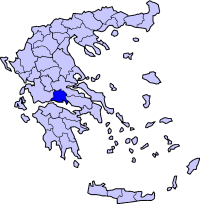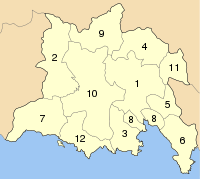Phocis
| Phocis Prefecture Φωκίδα |
|
|---|---|
 |
|

|
|
| Country: | |
| Capital: | Amfissa |
| Population: | 49,576 (2005)Ranked 47th |
| Area: | 2,120.564 km² (819 sq.mi.) Ranked 32nd |
| Density: | 23 /km² (61 /sq.mi.) |
| Number of provinces: | 2 |
| Number of municipalities: | 12 |
| Number of communities: | none |
| Postal codes: | 33x xx |
| Area codes: | 226x0, 26340 |
| Licence plate code: | ΑΜ |
| ISO 3166-2 code: | GR-07 |
| Website: | www.fokida.gr |
Phocis (Greek, Modern: Φωκίδα, IPA: [foˈkiða], Ancient/Katharevousa: Φωκίς, IPA: [foˈkis]) is an ancient district and a modern prefecture of Greece, located in Central Greece, stretching from the western mountainsides of Parnassus on the east to the mountain range of Vardousia on the west, upon the Gulf of Corinth.
Contents |
Geography
Ancient Phocis was about 1,619 km² (625 mi²) in area, bounded on the west by Ozolian Locris and Doris, on the north by Opuntian Locris, on the east by Boeotia, and on the south by the Gulf of Corinth. The massive ridge of Parnassus (2,459 m/8,068 ft), which traverses the heart of the country, divides it into two distinct portions.
Modern Phocis has an area of 2120 km² (819 mi²), of which 560 km² (216 mi²) are forested, 36 km² (14 mi²) are plains, and the remainder is mountainous.[1]
Being neither rich in material resources nor well placed for commercial enterprise, Phocis was mainly pastoral. No large cities grew up within its territory, and its chief places were mainly of strategic importance.
History
The early history of Phocis remains quite obscure. During the Persian invasion of 480 BC the Phocians at first joined in the national defence, but, by their irresolute conduct at the Battle of Thermopylae lost that position for the Greeks; at the Battle of Plataea they were enrolled on the Persian side. In 457 BC an attempt to extend their influence to the headwaters of the Cephissus in the territory of Doris brought a Spartan army into Phocis in defence of the "metropolis of the Dorians". A similar enterprise against Delphi in 448 BC was again frustrated by Sparta, but not long afterwards the Phocians recaptured the sanctuary with the help of the Athenians, with whom they had entered into alliance in 454 BC. The subsequent decline of Athenian land power had the effect of weakening this new connection; at the time of the Peloponnesian War Phocis was nominally an ally and dependent of Sparta, and had lost control of Delphi.
In the 4th century BC Phocis was constantly endangered by its Boeotian neighbours. After helping the Spartans to invade Boeotia during the Corinthian War (395–94 BC), the Phocians were placed on the defensive. They received assistance from Sparta in 380 BC, but were afterwards compelled to submit to the growing power of Thebes. The Phocian levy took part in the inroads of Epaminondas into Peloponnesus, except in the final campaign of Mantinea (370–362 BC), from which their contingent was withheld. In return for this negligence the Thebans fastened a religious quarrel upon their neighbours, and secured a penal decree against them from the Amphictyonic synod (356 BC). The Phocians, led by two capable generals, Philomelus and Onomarchus, replied by seizing Delphi and using its riches to hire a mercenary army. With the help of these troops the Phocian League at first carried the war into Boeotia and Thessaly, and though driven out of the latter country by Philip of Macedon, maintained itself for ten years, until the exhaustion of the temple treasures and the treachery of its leaders placed it at Philip's mercy. The conditions which he imposed – the obligation to restore the temple funds, and the dispersion of the population into open villages – were soon disregarded. In 339 BC the Phocians began to rebuild their cities; in the following year they fought against Philip at Chaeronea. Again in 323 BC they took part in the Lamian War against Antipater, and in 279 BC helped to defend Thermopylae against the Gauls.
Henceforth little more is heard of Phocis. During the 3rd century BC it passed into the power of Macedonia and of the Aetolian League, to which in 196 BC it was definitely annexed. Under the dominion of the Roman republic its national league was dissolved, but was revived by Augustus, who also restored to Phocis the votes in the Delphic Amphictyony which it had lost in 346 BC and enrolled it in the new Achaean synod. The Phocian League is last heard of under Trajan.
Phocis today
Phocis is today a prefecture and the capital is at Amfissa, formerly called Salona. With a population of 48,284 (2001), it is Greece's 8th-least populous prefecture, and has a population density of less than 23 persons per km² (59/mi²).[2] In the summer months, the population nearly doubles due to the influx of toursists.[1] The neighboring prefectures are Aetolia-Acarnania to the west, Phthiotis to the north and Boeotia to the east.
The communities include in the present-day Phocis are Amfissa, Delphi (near Boeotia), Galaxidi, Itea.
Most of the villages are founded in the south, the southwest and the west, especially in areas from Amfissa to Itea. The north and the east are leastly populated.
Much of the south and east are deforested and rocky and mountainous while the valley runs from Itea up to Amfissa. Forests and greenspaces are to the west, the central part and the north.
Its reservoir is the Mornos Dam on the Mornos river. It covers nearly 1 km to 3 km². It was completed in the 1960s, and GR-48 was extended to pass through the dam.
Transport
- Greece Interstate 3, NE
- Greece Interstate 27, Cen., N
- Greece Interstate 48, SW, Cen., SE
- E65, SW, S, SE
People
Modern Phocis was inhabited by several Greek tribes since antiquity, mainly by Phocians, Locrians and Dorians, which were intermingled and formed the present-day Phocian population, with a unique linguistic and cultural heritage, frequently mentioned as Roumeliotes.
Provinces
- Province of Dorida - Lidoriki
- Province of Parnassida - Amfissa
Note: Provinces no longer hold any legal status in Greece.
Municipalities
Phocis prefecture contains 12 municipalities.[1][3]
| Municipality | YPES code | Seat (if different) | Postal code |
|---|---|---|---|
| Amfissa | 5101 | 331 00 | |
| Delphi | 5105 | 330 54 | |
| Desfina | 5106 | 330 50 | |
| Efpalio | 5107 | 330 56 | |
| Galaxidi | 5103 | 330 52 | |
| Gravia | 5104 | 330 57 | |
| Itea | 5108 | 332 00 | |
| Kallieis | 5109 | Mavrolithari | 330 63 |
| Lidoriki | 5110 | 330 53 | |
| Parnassos | 5111 | Polydrosos | 330 51 |
| Tolofona | 5112 | Erateini | 330 58 |
| Vardousia | 5102 | Krokyleio | 330 61 |
See also: List of settlements in the Phocis prefecture
Persons
- Giannis Skarimpas (September 28, 1893 in Agia Efthymia Parnassidos - January 21, 1984)
Sporting teams
Here are the most popular sporting teams in the prefecture. All of the teams are under the Fokida Football Guild Union in which it existed since 1985 after the separation and dissolution of the Fokida-Fhtiotida Football Guild Union
- Androutsos Gravia - Gravia
- Asteras Iteas - Itea
- Doxa Desfina - Desfina
- Isaia Desfina - Desfina
- Diagoras Polydrosos - Polydrosos
- Dorikos Nea Dorida - Nea Dorida
- Fokikos - Amfissa
- A.O. Malesina - Malesina
References
- ↑ 1.0 1.1 1.2 "History". Prefecture of Fokida (2001-2002). Retrieved on 2007-05-03.
- ↑ "Information about Fokida". ellada.net. Retrieved on 2007-05-03.
- ↑ "Municipalities". Prefecture of Fokida (2001-2002). Retrieved on 2007-05-03.
External links
- Fanaticus website: Phokians, 668–450BC
- http://www.grecian.net/GREECE/centralgreece/fokida/fokida.htm
- http://hellas.teipir.gr/prefecturesenglish/Fokidas/Delfoi.htm
- In French:
- http://hellas.teipir.gr/prefectures/greek/Fokidas.htm (in Greek)
This article incorporates text from the Encyclopædia Britannica Eleventh Edition, a publication now in the public domain.